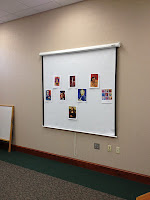 |
| River rock helps with drainage. |
As part of the Dig Into Reading theme for Summer Reading, we are offering a monthly series of programs called Garden Gang. This week we held our first program. Afterwards I typed up some notes.
This month we planted seeds to take home and plants to grow at the library. We hope that next month there will be some tomatoes to harvest and share as part of the program.
Story:
 |
| Getting top soil for the pots. |
Activities:
- Plant basil plants, tomato plants and mint plant into containers for the “patio” area.
- Take home: biodegradable seed cups (egg cartons and toilet paper rolls) with seeds (basil and marigold) sown.
Funds spent: $67 (plants, seeds, soil, river rock, planters, hand spades…)
Number of Attendees: 15 - ages 5-11.
 |
| Making a hole for the plant. |
Notes:
- 16 registered.
- Definitely do this program outside! Too messy for inside.
- Three 40-pound bags of top soil are just about perfect. We had some soil left over, but used it with the leftover seeds.
- One packet of seeds is plenty!
- Each child was given six marigold seeds (for egg cartons) and four basil seeds (for the TP rolls). Two seeds were put in each.
- We had three each tomato and basil plants (different varieties) and one mint plant. We put the kids in small groups to work together planting.
- We had the kids put about 1 ½ inches of river rock in the bottoms of each pot. This was to help with drainage.
- The TP rolls had mixed results. The thinner rolls did not work as well as the thicker ones.
- TP roll an egg carton planters found here.
- We lined a delivery crate with a disposable plastic tablecloth and put
the top soil in it. Next time have at
least two crates done this way.

 |
| Planting basil. |
Things to remember:
- Watering your plants once a week should be enough…however check in on your plants to be sure. They should be damp, but not wet…you want them to grow, not rot. To keep the water from making a mess under the planters, place them on a plate.
- Keep the planters warm and out of direct sunlight.
- In about two to three weeks you should be ready to transplant them into the ground or into a regular planter!
- The best thing about using these cardboard based planters is that once the seedlings are large enough to be transplanted you can actually plant the container as well. There is no need to fuss with removing the plant from the container…it will biodegrade in the new pot or in the garden.
 |
| Making pots from toilet paper rolls. |
Marigolds:
- When the plants are two inches high, they are ready to be transplanted.
- These flowers love the sun!
- When transplanted into the ground, place the plants eight inches apart.
- Flowers should arrive in 30-45 days.
 |
| Planting seeds in egg cartons. |
Basil:
- Basil plants need at least six hours of sun a day. Be sure to transplant them where they will receive lots of sun.
- Space plants about 10" apart. They will bush out. Begin pinching the tops off once the plants reach about 6" in height. If you don't pinch or harvest, the plants will grow tall and gangly, with few leaves and will bolt to seed.
 |
| The library's patio garden. |











